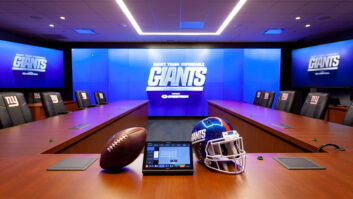

Don’t Overlook Commissioning
Two Pro AV MarketWatch surveys caught my eye last year. Conducted by PRO AV and InfoComm International, the first survey indicated that formal commissioning of AV systems was ?the sole responsibility of the AV systems integrator, with little or no involvement of the AV consultants?. The second reported that design/build projects provided the most revenue for contractors by a 3 to 1 margin over competitively bid projects.
AV MarketWatch surveys caught my eye last year. Conducted by PRO AV and InfoComm International, the first survey indicated that formal commissioning of AV systems was “the sole responsibility of the AV systems integrator, with little or no involvement of the AV consultants” (September 2007). The second reported that design/build projects provided the most revenue for contractors by a 3 to 1 margin over competitively bid projects (December 2007).
It’s probably safe to say that most competitively bid projects are consultant-designed projects and that most design/build projects are not. My question: Is there a correlation between the results of these two surveys? Do contractors make more money on design/build projects because they don’t fully commission the AV systems? Based on my own observations and conversations with other consultants, I say there’s a correlation. If that’s true, the client is not getting what they should out of the process.
Regardless of project size, most competitively bid projects include a system commissioning or testing procedure to ensure the system meets certain technical and operational goals. This includes verifying signal levels, freedom from hum and noise, speech intelligibility, and image uniformity to name a few. The list can, and usually does, go on for a few pages.
I don’t know of any consultant who will turn over this function to a contractor without some supervision. More often than not, a consultant wants to be directly involved in the process, because as we’ve pointed out before, commissioning is a critical phase in the project that ensures the client gets what he paid for. The question we’re all asking—owner, consultant, contractor—is whether the system will work the way it was imagined, designed, and installed. It’s not an issue of not trusting the contractor.
NOTHING ARBITRARY
At the end of almost every consultant-generated specification or RFP document is a list of items that the contractor must attend to during construction and prior to notifying the consultant, the architect, and the owner that the project is complete and ready for final inspection, system testing, and adjustment. The list includes adjustments to the audio, video, and control equipment of a system. It’s not an arbitrary list inserted to make life difficult for the contractor. It’s part of closing the loop on the project.
At the beginning of every project, we take the pulse of the client to determine their expectations for system operations and goals. We translate those “soft” goals into a working system by applying our technical knowledge to a set of problems, translating those solutions into design documents that are then executed by the contractor or integrator. Commissioning closes the loop—it enables us to make sure we have achieved the client’s goals.
What’s involved in commissioning an AV system? Good question, and one that is being discussed by the Consultant’s Councils for both InfoComm and NSCA. It’s also a question that has been dealt with, to some degree or another, in the rest of the construction industry. The Building Commissioning Association states, “Building commissioning provides documented confirmation that building systems function according to criteria set forth in the project documents to satisfy the owner’s operational needs.” It’s a pretty broad definition and focused predominantly on building systems, such as mechanical and electrical systems. It clearly reaches back into the original design intent and programming documents developed by the design team and reaches into the installation and operation of the building systems.
When it comes to AV systems, it may be obvious that commissioning deals with the basic areas of our industry—sound systems, display systems, control systems, and the infrastructure systems that tie them together. But the devil is in the details.
In sound reinforcement systems, for instance, we have to come to grips with issues of what constitutes adequate audience coverage. What are acceptable sound pressure levels for the listeners? What is the overall signal-to-noise ratio of the system? How much gain is there before feedback?
In other words, how much leeway should be built into the process of measuring gain before feedback and bandwidth before we declare a system has achieved the design goals? Plus or minus 1 dB? 2 dB? 4 dB? How much of this is objectively measurable versus a subjective sense? The commissioning process compares the design goals with the final outcome.
We face similar problems with visual display systems. Brightness, contrast, linearity, gain, bandwidth. How close have we come to achieving the design goals of the control system? Is it enough to watch a 6-year old operate the system and declare it good? Can the CTO clearly read and understand the control buttons and work his way through the system? When it comes to infrastructure—raceway systems, power conditioning and distribution, cable plant—can the client understand all the information presented? Is it important to them? What is important to us may not be important, nor understandable, to them.
RELATIONSHIP STRENGTHENER
My observation, and concern, is that commissioning on design/build projects is typically done in a haphazard manner because there is little time or money left at the end of the job to properly test the AV systems. I once worked with a contractor who told me they didn’t know if I was serious about the testing requirements in my specifications, so they had not done the required tests. I have also heard from frustrated clients that the contractor refused to give them operations and maintenance information, or as-built documents for their system. To the client, it appeared the contractor was holding back as a means of keeping the client from going to another integrator.
Now before everyone gets their dander up and starts flaming me, I’m not trying to re-open old wounds. I’ve also heard from contractors of consultants who were inconsistent in enforcing their commissioning and testing standards, among other egregious acts that raise the ire of the contracting and integration community. Contractors and consultants both should do full commissioning, whether the project follows the traditional design/bid/build approach or travels the design/build road.
The old saw that the last 10 percent of a job takes 90 percent of the labor didn’t appear out of thin air. That last 10 percent (sometimes 20 percent), which represents project commissioning, takes care and effort. Done carefully and documented accurately, it can increase the owner’s satisfaction and strengthen the relationship between the contractor and the consultant, or, in the case of a design/build project, between the contractor and the client.
Thom Mullins is a senior consultant with BRC Acoustics & Technology Consulting in Seattle. He can be reached at [email protected].










